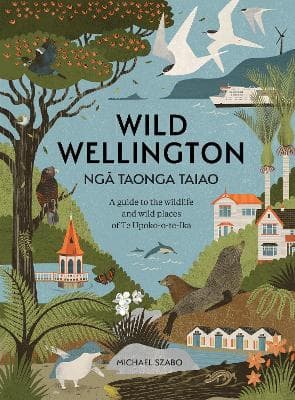Review: Wild Wellington Ngā Taonga Taiao, by Michael Szabo
Reviewed by Rebekah Stretton
Michael Szabo is the guy who came up with the world famous ‘Bird of the year’ competition. He is also the author of Native Birds of Aotearoa (Te Papa Press, 2022), the editor of Birds New Zealand Magazine, and has written extensively on the environment, as well as working for Greenpeace and Forest and Bird. A passion for wildlife, especially birds and conservation, drives him. You get the impression that without a page limit, he could write endlessly and with enthusiasm on these subjects.
Wild Wellington Ngā Taonga Taiao: A guide to the wildlife and wild places of Te Upoko-o-te-Ika focuses on the proliferation of native and endemic flora and fauna found across the Wellington region. The book is divided into four regions: Wellington City, Porirua and Kāpiti, the Hutt Valley and the South Coast and then subdivided into a total of thirty places to visit. Locations are selected carefully for diversity with perhaps a heavy weighting towards Szabo’s home region of the South Coast. Obvious places like Zealandia and Pariwhero Red Rocks (you can see seals here) show up, as well as places you might go often like the Wellington Waterfront, and also the ones you might not think of as a wildlife experience, such as the Cook Strait Ferry.
A whopping 500+ species are included in the book. Each chapter is crammed with lists of what to find in each location, plus interesting and relevant snippets of information - where and when you might see things, facts and details of rare historical sightings of species, as far back as the 1930s. If you are a nature enthusiast, you will appreciate the quantity of species, common and rare. As an example, this is how several species are listed in a certain area:
‘Be on the lookout for karearea New Zealand falcons and kererū New Zealand pigeons soring over the awa here, and listen for the loud zzhweeesht calls of koekoeā long-tailed cuckoo in spring and summer, or the mellifluous song of the korimako bellbird chiming out from the surrounding forest. Piwakawaka New Zealand fantail, riroriro grey warbler and titipounamu rifleman are also possible.’
Sazbo consistently highlights past and future conservation efforts, taking note of their positive outcomes such as the effort to reinstate wild kiwi:
‘The releases at Terawhiti Station were part of the project’s aim to ‘restore a large-scale wild kiwi population to Wellington’s backyard’… in November that year two healthy chicks were found in a burrow near Mākara, the first hatched in the wild west of the capital for at least 100 years.’
His optimism is evident throughout. He says of the Wellington Harbour: ‘On a still, clear day when the sea can be glassy smooth, the surface reflects the sky like a mirror… these are the perfect conditions to take the ferry and watch for kororā...’ If you are local you will know the saying that there are only three good days a year in Wellington; Google tells me that there are in fact 26. If you read this book you will probably want to spend one of them looking for penguins on the ferry to Matiu Somes Island.
Each region begins with an introduction that provides the perspective of tangata whenua, adding depth with historical and cultural insights. Three are written by Liz Mellish MNZM (Te Ātiawa, Taranaki, Ngāti Ruanui) and one by Rawiri Faulkner (Pou Toa Matarau, Te Rūnanga o Toa Rangatira). Mellish describes her writing as ‘some short insights into the way mana whenua inhabit this landscape.’
Impressively Szabo has taken most of the photographs himself, testament to the years of research and exploration that must have gone into this book. Images clearly frame the subject and make it easy to identify each species. However, this isn’t a guidebook with checklists or multiple photos of each species - there are far too many for that. Information about track times and the best time of year to see species is hidden within the chapters so they need to be read from start to finish before you head out, perhaps armed with a pen and a smartphone.
Who will read this book? A friend from out of town who was heading to Kāpiti Island picked it up and said ‘this is exactly what I was looking for’. My family will use this as a starting point for searching and out species on the days when we are not rushing past on our bikes. If you already know your tūī, kererū and pōhutukawa this is the next step for discovering native flora and fauna. It is a treasure hunters’ guide to nature in the Wellington region.
Reviewed by Rebekah Stretton
